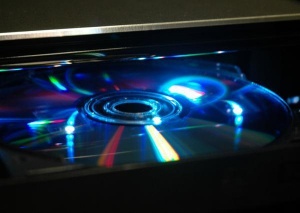May 20 2009
Futuristic discs with a storage capacity 2,000 times that of current DVDs could be just around the corner, thanks to new research from Swinburne University of Technology. For the first time researchers from the university's Centre for Micro-Photonics have demonstrated how nanotechnology can enable the creation of 'five dimensional' discs with huge storage capacities.
 Researchers in Australia have demonstrated how nanostructured material can be incorporated onto a disc in order to increase data capacity, without increasing the physical size of the disc. (Credit: Peter Zijlstra/James Chon)
Researchers in Australia have demonstrated how nanostructured material can be incorporated onto a disc in order to increase data capacity, without increasing the physical size of the disc. (Credit: Peter Zijlstra/James Chon)
The research, carried out by Mr Peter Zijlstra, Dr James Chon and Professor Min Gu was published today in the scientific journal Nature.
The Nature article describes how the researchers were able to use nanoscopic particles to exponentially increase the amount of information contained on a single disc.
“We were able to show how nanostructured material can be incorporated onto a disc in order to increase data capacity, without increasing the physical size of the disc,” Gu said.
Discs currently have three spatial dimensions, but using nanoparticles the Swinburne researchers were able to introduce a spectral – or colour – dimension as well as a polarisation dimension.
“These extra dimensions are the key to creating ultra-high capacity discs,” Gu said.
To create the 'colour dimension' the researchers inserted gold nanorods onto a disc's surface. Because nanoparticles react to light according to their shape, this allowed the researchers to record information in a range of different colour wavelengths on the same physical disc location.
This is a major improvement on current DVDs that are recorded in a single colour wavelength using a laser.
The researchers were also able to introduce an extra dimension onto the disc using polarisation. When they projected light waves onto the disc, the direction of the electric field contained within them aligned with the gold nanorods. This allowed the researchers to record different layers of information at different angles.
“The polarisation can be rotated 360 degrees,” Chon said. “So for example, we were able to record at zero degree polarisation. Then on top of that, we were able to record another layer of information at 90 degrees polarisation, without them interfering with each other.”
Some issues, such as the speed at which the discs can be written on, are yet to be resolved. However the researchers – who have already signed an agreement with Samsung – are confident the discs will be commercially available within 5 – 10 years.
The discs are likely to have immediate applications in a range of fields. They would be valuable for storing extremely large medical files such as MRIs and could also provide a boon in the financial, military and security arenas.
The researchers' ground breaking achievements would not have been possible without the long time support of the Australian Research Council.